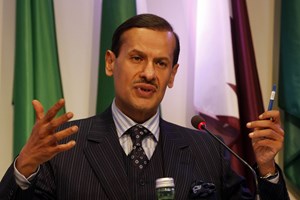Saudi’s oil cuts appear prophetic as market risks grow
LONDON (Bloomberg) --For Saudi Arabia, bad news in the oil market has rarely been such a vindication.
Two weeks ago, the world’s biggest crude exporter stunned energy traders by announcing that -- rather than restore halted production as planned -- it would slash supplies by a further 1 million barrels a day.
The resurgent pandemic necessitated “preemptive” action to protect the oil recovery, said Energy Minister Prince Abdulaziz bin Salman. That ran counter to the view of the kingdom’s OPEC+ ally, Russia, but since then plenty of evidence has emerged that Riyadh made the right call.
On Tuesday, the International Energy Agency slashed forecasts for world oil demand in the first quarter as countries hunker down to contain new coronavirus outbreaks. China, which has powered crude’s recovery until now, is locking down cities again and discouraging travel over the Lunar New Year holidays.
“It will take more time for oil demand to recover fully as renewed lockdowns in a number of countries weigh on fuel sales,” the Paris-based IEA said in its monthly report.
Oil prices have rallied by about 8% since the Organization of Petroleum Exporting Countries and its allies surprised the market on Jan. 5. The 23 nations led by Saudi Arabia and Russia had been expected to add another monthly supply increment of as much as 500,000 barrels a day. Instead most of the group postponed the return of halted production, and Riyadh said it would make an additional cutback in February and March.
Brent futures climbed above $57 a barrel last week, the highest in almost a year. That’s brought relief to the depleted coffers of OPEC+ members, including Saudi Arabia, which needs prices far above current levels to cover government spending. Oil revenue earned by the cartel slumped 46% to an 18-year low of $323 billion last year, according to the U.S. Energy Information Administration.
Those financial gains don’t come without risks, namely that the Saudis could over-tighten the market. If the rally encourages a flow of new supplies from U.S. drillers and other rivals, that kingdom’s additional cuts would have backfired. A big chunk of shale oil production is profitable at current prices, according to IEA Executive Director Fatih Birol.
Moscow’s support for further production increases was motivated in part by the fear that any supply gap left by OPEC+ cuts would be filled by rivals. It’s why Russian Deputy Prime Minister Alexander Novak tried to dissuade Prince Abdulaziz from making his extra cutback at the January meeting.
Signs of Weakness
So far, evidence from the oil market has validated the kingdom’s preemptive action.
In India, sales of diesel -- the country’s most-used fuel and a proxy for economic health -- dropped by 6.6% in the first half of January compared with the same period in December, and was down 3.5% from a year earlier, according to people familiar with preliminary data. Sales of gasoline, jet fuel and liquefied petroleum gas also declined.
In Europe, road use in the UK, France, Italy and Spain was down 37% in early January compared with pre-pandemic levels, according to data compiled by Bloomberg. Excluding year-end holidays, that’s the weakest since June.
The erosion of the demand recovery, driven by new lockdowns to control the spread of highly infectious new variant of Covid-19, is reflected in key price indicators. The premium on December 2021 Brent contracts versus those a year hence, which signals tight fundamentals, surged to the highest since 2018 in the days following the OPEC+ meeting, but has narrowed 20% in the past week to $1.76 a barrel.
With the additional Saudi curbs, oil inventories are on track to decline steadily in the first half of the year, eliminating much of the surplus that built up during the initial months of the pandemic last year, according to the IEA.
The supply shortfall will deepen in the second half of the year as the deployment of vaccines revives economic activity, giving Saudi Arabia and fellow OPEC+ nations an opportunity to open the taps. That would herald a turning point for the alliance -- the payoff for years of sacrificed sales to prop up the market.
“Much more oil is likely to be required,” the IEA said. If shale drillers remain docile, “OPEC+ may start to reclaim the market share it has steadily lost to the U.S. and others since 2016.”



